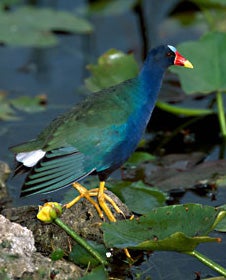SCIENTIFIC NAME:
Porphyrio martinica
STATUS:
Breeder. Uncommon in summer and uncommon to rare in spring and fall in Inland Coastal Plain and Gulf Coast regions. Occasional in spring in Mountain and Tennessee Valley regions. MODERATE CONSERVATION CONCERN.
DESCRIPTION:
The purple gallinule is a brightly colored marsh bird comparable in size to a chicken. The adult birds length is around 12 inches. Adults have green/olive backs and wings. The head, neck, breast and belly are an attractive blue/purple. The undertail coverts are white, eyes are red, and the beak is red with a yellow tip. The forehead is covered by a light blue shield. Feet and legs are bright yellow. The sexes are similar is coloration. Wingspan is normally around 21 inches and weights range from below 7 ounces to slightly over 10 ounces. The adult has a red bill with a yellow tip. The purple gallinule is a poor flyer but is an excellent wader. Long toes allow this bird to maneuver about in its aquatic environment and provide a stable platform while walking across floating vegetation. Vocalizations include a Kr-r-ruk, kek, kek, kek and chucks.
DISTRIBUTION:
The breeding and nesting range would include most of the southeastern United States with most activity along the coastal areas. States along the Gulf of America and the Atlantic Ocean are home to the highest densities. Mexico, Central and South America are also included in the breeding range. Most birds over winter south of the United States with the exception of southern Florida.
HABITAT:
Occur in a variety of wetlands including fresh and saline marshes, lakes, impoundments and flooded fields. Stable water levels and abundant vegetation are especially important components. Nesting habitat is similar. Nesting occurs on floating and emergent vegetation. Habitat utilized during migration and on wintering areas is not well known.
FEEDING HABITS:
Purple gallinules are omnivores and feed on a variety of plants and animals. Seeds of grasses and aquatic plants, flowers of aquatic plants, agricultural crops (rice), aquatic insects and invertebrates, larvae, dragonflies, frogs, grasshoppers, spiders, crayfish and mollusks are consumed.
LIFE HISTORY AND ECOLOGY:
Courting activities for the purple gallinule include nibbling, bowing, billings, swaying and the squat arch. Nesting territories are established and defended. Nesting occurs May through August. Nests are constructed of stems, leaves and vegetation. Clutch size ranges from six to ten eggs. Incubation ranges from 18 to 20 days. Both sexes participate in incubation, feeding and care of the precocial (down covered, active) chicks. A ritual is followed when mates change positions during incubation. The bird coming to relieve its mate presents a leaf that is accepted by the incubating bird and added to the nest. Young begin to forage between one and two weeks and by three weeks of age they are can feed themselves without assistance from the parents. The young can complete short flights after seven weeks. Birds are preyed upon by turtles and alligators. The most urgent threat is probably the loss of habitat in the form of utilized wetlands.
REFERENCES:
Helm, Robert N. 1994. Purple Gallinule. Pages 159-165 in T. C. Tacha and C. E. Braun, eds. Migratory Shore and Upland Game Bird Management in North America. International Association of Fish and Wildlife Agencies, Washington D. C.
Sykes, Paul W. Jr.1985. Purple Gallinule. Pages 304-306 in John Farrand Jr. editor. The Audubon Society Master Guide to Birding. Alfred A. Knopf, Inc. New York, New York.
AUTHOR:
Richard Tharp, Wildlife Biologist, Alabama Division of Wildlife & Freshwater Fisheries






